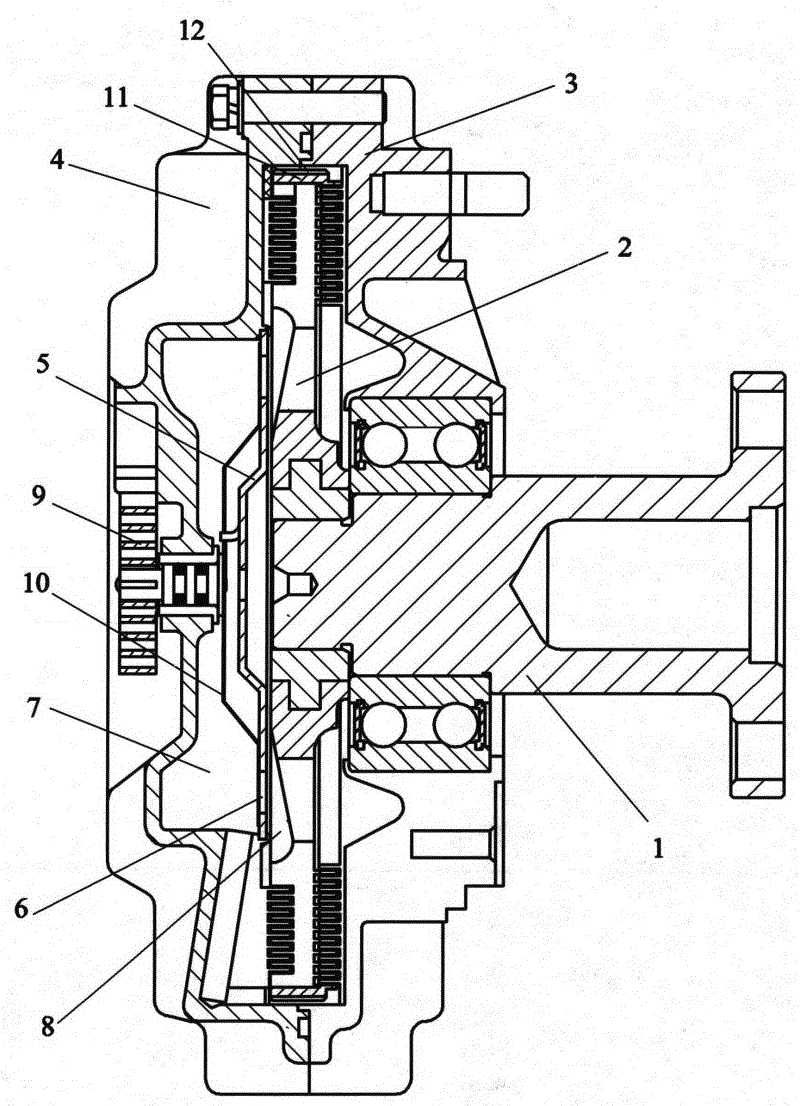When the temperature is low, the silicone oil does not flow, the fan clutch disengages, and the fan speed slows down, basically idling. When the temperature is high, the viscosity of the silicone oil makes the fan clutch combine, so the fan and the water pump shaft rotate together to adjust the engine temperature.
The temperature sensing elements of the silicone oil fan clutch are all bimetallic coil spring temperature sensors. Its working process is as follows:

As the engine load increases and the coolant temperature rises, the temperature of the airflow through the radiator core also increases. The high-temperature airflow blows on the bimetal temperature sensor, which causes the bimetal sheet to be deformed by heat, and drives the valve sheet drive pin and the control valve sheet to deflect an angle. When the airflow temperature exceeds 65°C, the oil inlet hole A on the driven plate is opened, and the silicone oil in the oil storage chamber enters the working chamber through this hole.
The viscous silicone oil flows into the gap between the active plate and the driven plate and between the active plate and the clutch housing, and transmits the torque on the active plate to the clutch housing, which drives the fan to rotate at a high speed, and the clutch is in the engaged state at this time. The silicone oil entering the working chamber is thrown to the outer edge under the action of centrifugal force, pushes open the check valve 1 and flows back to the oil storage chamber through the oil return hole B on the driven plate, and then enters the working chamber. Repeat this to form a cycle. When the silicone oil circulates, it transfers heat to the front cover and clutch housing cast with radiating fins to be cooled, so as to avoid excessive temperature of the silicone oil during operation.
When the temperature of the airflow blowing to the bimetal temperature sensor is lower than 35℃ due to the load drop of the engine, the control valve will close the oil inlet hole A, the silicone oil will no longer enter the working chamber, and the silicone oil originally in the working chamber will be closed. It will continue to return to the oil storage chamber under the action of centrifugal force until it is emptied. The clutch is now disengaged again, and the fan is idling and slipping.
① Inspection in cold state: After the engine has stopped rotating for a period of time, it should be more laborious to turn the fan blades by hand. When the engine is started and the cold car is running at a medium speed for 1-2 minutes, it should be easier to turn the fan by hand. These are all silicone oil fans that work normally.
Because when the engine is turned off at normal working temperature, the working chamber of the fan is filled with silicone oil, and the main and driven discs of the fan still maintain a certain relative fixed connection. It should feel more laborious when turning the blades (sometimes the fan does not rotate when the temperature is low, maybe the silicone oil cannot return immediately).
When the engine starts and runs at a medium speed for 1~2 minutes, the silicone oil in the working chamber has flowed back to the oil storage chamber, and the silicone oil in the storage chamber cannot flow into the working chamber due to the low temperature and the valve plate cannot be opened. The connection between the moving plates is lost, so it is easier to move the blades by hand. Pry the end of the bimetallic coil spring out of the fixing groove, then turn the bimetallic coil spring counterclockwise, and observe the rotating shaft, it should be able to rotate until it stops. After the test, press the end of the bimetallic coil spring into the fixing groove. If the shaft cannot rotate, the clutch is damaged and the assembly should be replaced.
② Inspection in hot state: If it is found that the water temperature is continuously rising or even boiling, in addition to the common faults such as the fan belt should be checked, the silicone oil fan should be checked.
After starting the engine, when the temperature is close to 90℃~95℃, listen carefully to the sound of the fan, and observe the change of the fan speed. If the noise increases significantly within a few minutes, the speed increases rapidly, and even runs at full speed, indicating that the valve plate has been opened. , the oil outlet has been opened, and the silicone oil has flowed into the working chamber to make the main and driven discs engage, indicating that the silicone oil fan works well.
At this time, if the engine is turned off, and then the fan blades are moved by hand, it should be very laborious.




